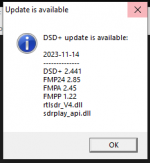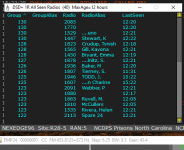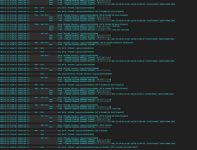
Change Log
----------
DSD+ 2.441
Some command line options and keyboard commands have been removed.
DSDPlus -h lists all command line options and keyboard commands.
The size of the text in the various DSD+ windows is controlled via the DSD+ Window menu.
To change the size of the various DSD+ windows, left-drag the double-ended arrow that
appears when you move the mouse pointer to a DSD+ window's lower right corner.
Note that the DSD+ Channel Activity window is auto-sizing; the only way to manually
adjust its size is to modify the size of the text that it displays.
Handling/parsing of data files (DSDPlus.networks, .sites, .frequencies, etc.) has been
modified; if DSD+ reports errors in files, inspect the indicated lines carefully.
Added decoding / trunk tracking of TIII Broadcast Talkgroup calls.
Additional DMR GPS/AVL location messages are now decoded.
Better handling of neighbor lists that have multiple/duplicate references to a given site.
Added handling of NXDN repeaters that send malformed SACCH messages.
Improved handling of P25 TDULC messages.
Added decoding of Harris P25 Talker Alias messages.
Decoded subscriber radio aliases are added to radio entries in the DSDPlus.radios file.
Added decoding of Harris P25 GPS/AVL messages.
Added decoding of conventional P25 GPS/AVL messages.
Added raw decoding of P25 packet data calls. These are normally found on P25 trunking systems.
Use the Data Calls priority settings in the DSD+ Control menu to enable or disable
auto- tuning / trunk following of P25 data calls.
These calls typically occur on dedicated channels; you may also manually park a receiver
on one of these channels.
Raw P25 packet data messages are written to a text file
named [mode-]DSDPlus[#modifier].packetData; each data block in a message is written
to a separate text line as hexadecimal byte values and ASCII text strings.
Raw P25 packet data messages are also written to a text file
named [mode-]DSDPlus[#modifier].packetData2; each complete data message is written
to a single separate text line as hexadecimal byte values. The message data in this file
can be sorted on any message byte offset by the Windows SORT command for analysis purposes.
Raw P25 packet data messages are also displayed in the DSD+ Packet Data window.
This scrollable window can buffer/display up to 500,000 lines of data.
P25 packet data is only buffered for this window when the window is open;
each time the window is closed/reopened, it will start with a blank display / no data.
A common packet data message type sent on P25 trunking systems is
ESP (Encapsulating Security Payload); these are encrypted and not decodable.
By examining the ASCII text displayed in the .PacketData file and the Packet Data window,
you may find TMS (Text Messaging Service) payloads.
Another common message is ACK responses; these are endpoints confirming that an entire
packet data message was received and decoded correctly.
FMP24 2.85
Minor internal changes.
Updated to auto-detect and support RTL-SDR Blog v4 dongles.
rtlsdr_V4.dll
DLL for RTL-SDR Blog v4 dongles; this file should be in FMP24's working folder.
FMPA 2.45
Minor internal changes.
FMPP 1.22
Minor internal changes.
Updated to SDRPlay API version 3.11
sdrplay_api.dll
DLL for SDRPlay API version 3.11; this file should be in FMPP's working folder.





